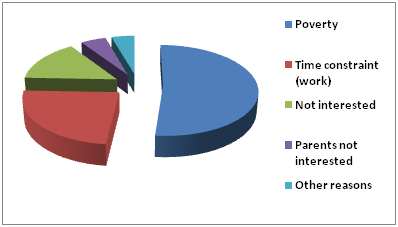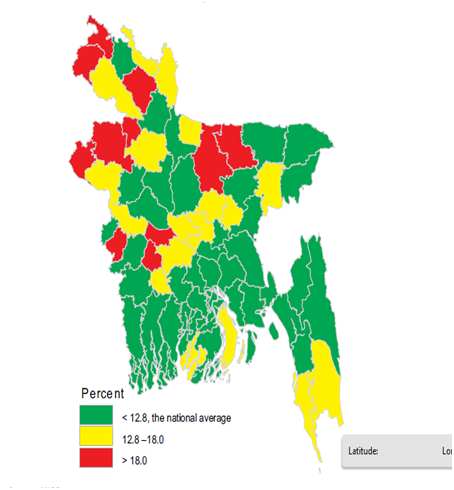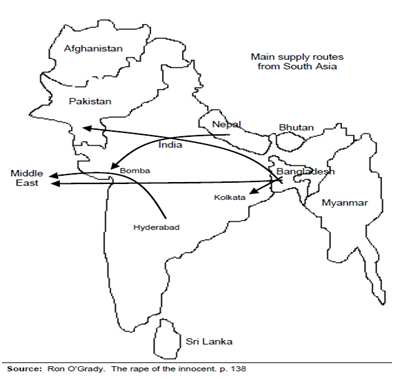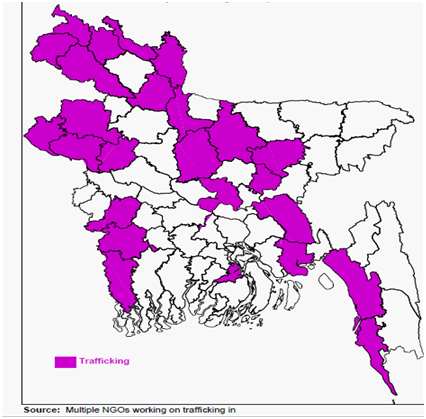EXECUTIVE SUMMARY-Most of us consider child labor exploitative and therefore, socially unacceptable. The study of child labor is, however, important not only for social reasons but also for economic ones. The impact of child labor on the economy works through its debilitating effect on education which is important component of human capital. The participation of children in work in home and outside is often considered to be one of the important reasons for low school enrolment in Bangladesh. An important effect of child labor is on demographic development in a country. It is generally found that poor countries with high rates of population growth have higher incidence of child work. In this study, the actual child laborers in Bangladesh are 3.2 million (ILO, report/ BBS, 2006) which age is 5-17years. About 421000 are domestic workers. The children are bound to do hazardous toils because of poverty. More than 1.3 million children work in hazardous situation. The Bangladeshi children deprived every winding of social and international aspects such as in trafficking, industrial works, household labors, early marriage, biri factory, forcedly prostitution, begging, less wages, helping in the vehicle etc. though the government of Bangladesh has taken many initiatives to prevent child labor and violation of child rights. But the achievement is not satisfactory, in this connection much phenomena are concerned; poverty is one of them. So, government, NGOs and public should take proper step to impoverish the vulnerable people, awareness buildings, enforcement of laws. The number of child laborers and victims of various disparities is quite alarming for our future generation.
1.1. Background of the study
Bangladesh is overpopulated country. Most of the people are poor. Many people migrating to cities in search of jobs. They live extreme poverty and the positions of their children are even worse. Specially, a large number of children is working and staying on the street. In Bangladesh, whose age is less than 18 year is consider as a child. If the actual age is seem to be up to 14 years. Child labor is work that exceeds a minimum number of hours, depending on the age of a child and on the type of work. Such work is considered harmful to the child and should therefore be eliminated. Social norms and economic realities mean that child labor is widely accepted and very common in Bangladesh. Many families rely on the income generated by their children for survival, so child labor is often highly valued. Additionally, employers often prefer to employ children because they are cheaper and considered to be more compliant and obedient than adults. When children are forced to work, they are often denied their rights to education, leisure and play.
Millions of children are reported not to attend school, however estimates vary. Among children aged 5-14, about five million, are economically active. “Child labor” is a narrower concept than “working children”. According to the International Labor Organization definition (right,2003), there are about 3.2 million child laborers in Bangladesh. Certain groups of children are more likely to work than others, for instance boys comprise about three-quarters of all working children. In slums almost one in five children aged 5-14 are child laborers, and of these, only 25 per cent attend school. Child employment rates increase with age, but even about two per cent of five-year-olds and three per cent of six-year-olds work. Of the estimated 16 million children in Bangladesh aged 10 to 14, over 6.8 million are working children. Forty-one percent of this group is girls. Children are engaged in over 300 different types of work activities of which 49 are considered harmful to their physical and/or mental well being. Intolerable forms of child labor, as categorized by the International Labor Organization (ILO, 2006), are domestic service, slavery or near slavery, hazardous occupations, and sexual exploitation. All of these forms are practiced in Bangladesh.
In practice, child labor laws in Bangladesh do not protect working children. Employers prefer children as they are cheap, productive and obedient. Children working in the industrial sector have no contract of employment and so find it difficult to stand up for themselves and fight for their rights. The demand by factories for child laborers is increasing all the time. The govt. formulates many acts and laws against violation of children’s right. All these laws prohibit the employment of children below 14 years of age. In spite of these laws, children can be found working in garment factories, hotels, brick making, biri factories, mechanical workshops, match factories, agricultural work, domestic work, and as garbage collectors and touts on buses and tempos. Child labor is a visible part of everyday life in Bangladesh: young children serve at roadside tea stalls, and weave between cars selling goods to motorists. Other children work in jobs that are hidden from view, such as domestic work, which makes monitoring and regulation difficult. On average, children work 28 hours a week and earn 222 taka (3.3 USD) a week. Many of the jobs that children in Bangladesh perform are considered „hazardous‟, and put their physical and mental development at risk. In 2002/03, the Bangladesh Bureau of Statistics (BBS) conducted the second National Child Labor Survey (NCLS).1 this survey has been designed and conducted in the context of the commitments made by the Government of Bangladesh, following the ratification of the International Labor Organization (ILO) Worst Forms of Child Labor Convention (No. 182) 1999. According to the survey, there are 4.9 million working children 14.2 per cent of the total 35.06 million children in the age group of 5-14 years. The total working child population between 5 and 17 years old is estimated at 7.9 million. Sometimes it makes a worse situation and much painful situation.
1.2. Objectives of the study
- To evaluate the poor people and their hazard situation
- To impact of the child on the economy and actual situation of Bangladesh.
- To know the child right and motivate for changing people’s attitudes.
- To make an idea that which is the most reasonable causes of child labor and how to reduces from Bangladesh.
1.3. Scope of the study
On the child right and violation of child right, there are many laws has made by the legislator, but in Bangladesh, it is not effectively use, so in these case effective applying procedure can be study in further. The violation of child right is increasing day by day, what is the future situation, it must be known and find out it reducing procedure may be future study.
1.4 Methodology of the study
It follows aggregation of information from different sources like publications, books, e-books and different articles. Those are studied well and gathered knowledge. Also vast data have collected from internet. All these data are analyzed in different way for finding different relevant things. Then I went to the different research institution and different places for adjusting. I also mind mapping the study then start writing to follow the specific instruction for writing. All these data are secondary data.
1.4. Limitation of the study
There was much opportunity to enrich the paper because the library of BPATC was richer with various books and relevant work papers. But I could not go through every winding of the every book and research papers. Sometimes, I have to go through with a bird’s eye view to. I have to accomplish this work by doing many tasks bi-laterally. So, I could not prepare the paper 100% earnestly as I keep in my mind. I can add something with this paper, but I have to set aside those for want of time. Interviewing by assessing the local people’s opinions about the issues and how they think about cope up the different. Information about relevant things is not more satisfactory.
When children are forced to work, they are often denied their rights to education, leisure and play. They are also exposed to situations that make them vulnerable to trafficking, abuse, violence and exploitation. Millions of children are reported not to attend school, however estimates vary. Among children aged 5-14, about five million, are economically active. “Child labor” is a narrower concept than “working children”. According to the International Laborers Organization definition (right), there are about 3.2 million child laborers in Bangladesh
Table1. Key Statistics of child labor
| Working children, aged 5-17 | 7.4 million | ||
| Working children, aged 5-14 | 4.7 million | ||
| Child laborers (according to definition, below), aged 5-17 | 3.2 million | ||
| Children engaged in hazardous labor, aged 5-17 | 1.3 million | ||
| Child domestic workers1 | 421,000 | ||
| Percentage of children (aged 5-14) engaged in child labor (2006) | National | Slum | Tribal |
| 12.8 | 19.1 | 17.6 | |
Source: International Labor Organization (ILO), Baseline Survey on Child Domestic Labor in Bangladesh, 2006, BBS/ UNICEF, Multiple Indicator Cluster Survey 2006, October 2007 All other statistics from Bangladesh Bureau of Statistics, Report on National Child Labor Survey, 2002-2003
2.1 Causes of child labor
Bangladesh is an economically poor country. Most of the people live in below poverty line and incase of high density all kinds of basic need are not able to meet anybody. The following reason is very much important
2.1.1. Poverty and family size
In Bangladesh the average family size is six persons. In families where children work, the father often works as either a rickshaw puller or day laborer and the mother as a domestic help. Poverty leads to quarrels; tension and can ultimately result in cruel treatment of children. The mother, being over burdened with work, can lose interest in her children and neglect them. 56% per cent of people of Bangladesh are landless. They either work on the land of others on a contract basis, or become floating labor moving from place to place. Without a stable income the children become a burden to parents and must find work for their own survival.
Table 2. Economically active children by region/ former district -2003.

2.1.2 Victims of migration
In general, neglected children migrate to big cities with their families or alone. Often they must beg or drift on the streets in order to earn a living and will consider any work that helps them survive.
2.1.3. Illiteracy & Ignorance
Many parents of working children are illiterate and unskilled with little prospect of being able to improve their situation. There is a lack of faith in the existing education system as it does not necessarily lead to employment. Many poor parents feel that it is better for their children to learn by working rather than sending them to school.
2.1.4. Child labor law and rights
In practice, child labor laws in Bangladesh do not protect working children. Employers prefer children as they are cheap, productive and obedient. Children working in the industrial sector have no contract of employment and so find it difficult to stand up for themselves and fight for their rights. The demand by factories for child laborers is increasing all the time.
2.1.5. Family breakdown
Migration of families, broken families, parental abuse and abandonment, all lead to child labor.
2.1.6. Natural calamities
Floods, land erosion, cyclones etc., have a devastating effect on many area of Bangladesh every year. This further increases the pressures on poor families and leads to many new children entering the labor force.
2.1.7. Status of living place
The children with disabilities engaged and at risk to be engaged with child labor interviewed are living in different places in different situations including on the street. Area wise status of living places shown in the following chart:
Figure1. Comparative child labourer rural and Urban area.

7 with families and 3 children do not have families and any shelter for stay at night. (Source: Alam et.l, December 2009).
Table 3. Percentage as of Working Children by Major Occupations
| Occupation | Urban | Rural | ||||||
Boys | Girls | Boys | Girls | |||||
| younger | old | younger | old | younger | old | Younger | old | |
| Farmworker | 0.00 | 3.81 | 0.00 | 0.00 | 38.75 | 55.40 | 6.67 | 29.63 |
| Fisherman | 0.00 | 1.90 | 0.00 | 0.00 | 6.25 | 5.83 | 6.67 | 3.70 |
| Forest and livestock worker | 0.00 | 0.00 | 0.00 | 0.00 | 10.00 | 2.04 | 0.00 | 0.00 |
| Servant/maid | 21.05 | 12.38 | 68.75 | 43.18 | 13.75 | 7.00 | 53.33 | 40.74 |
| Salesman/businessman | 52.63 | 29.53 | 0.00 | 0.00 | 12.50 | 12.83 | 6.67 | 3.70 |
| Production worker | 15.79 | 21.90 | 25.00 | 43.18 | 5.00 | 7.00 | 6.67 | 3.70 |
| Transport /communication worker | 5.26 | 7.62 | 0.00 | 0.00 | 2.50 | 1.46 | 0.00 | 0.00 |
| Day laborer | 5.26 | 2.86 | 0.00 | 0.00 | 5.00 | 1.46 | 0.00 | 0.00 |
| Other | 0.01 | 20.00 | 6.25 | 13.64 | 6.25 | 6.98 | 19.99 | 18.53 |
| Total | 100 | 100 | 100 | 100 | 100 | 100 | 100 | 100 |
These percentages are based on the number of working children who provided information about their current occupations. Occupational titles are from the 1995-1996 Household Expenditure Survey

2.2 Child works places
2.2.1. Child as Domestic Workers
Child Domestic service is a widespread practice in Bangladesh. The majority of child domestics tend to be 12 and 1 7 years old. But children as young as 5 or 6 years old can also be found working. A survey of child domestic workers found that 38 percent were 11 to 13 years old and nearly 24 percent were 5 to 10 years old. Child domestics works
long hours, getting up well before their employers and going to bed long after them. On 50 percent domestic workers work 12- 14 hours a day. Irrespective of their gender, Child domestic carry out all sorts of household work. Boys often perform tasks like going to the grocery, cleaning the drain, talking the garbage to roadside


bins, washing the car and sell nuts etc. On the other hand, girls have to iron the cloths, attend phone calls and serve the guests. The child domestic workers are often the least paid in the society, their remuneration ranging from 80 taka to 400 taka per month. In most of the cases, they hand over all their earnings to their parents, leaving nothing for themselves.
2.2.2 Working Hours and Earnings
Many children work long hours every day of the week. For example, some survey results show that half of the working children are toiling for nine hours or more per day. Sometimes, they also work in holidays, especially in the rural communities. A large majority of youngster toil as unpaid family workers, in the rural areas where working girls outnumber working boys. More than four in every five children work without pay. Also, the younger working children the lower the wage payment. In average girls are working more than boys and they get low money more than boys. Sometimes, many children work during the evenings or night as well. Children do not get overtime money. In one major survey, close to two-thirds of the child labor force in the agriculture are found to be working during these periods-three quarters of the boys and more than two-fifths of the girls. A large number of the girls working as housemaid are often obliged to spend the night in their employer’s household there by also exposing themselves to various abuses. For girls and boys the payment for domestic help ranges from taka 200-1300 per month in dhaka area. But in other district, they get low money from Dhaka.
2.2.3. Hazardous works
What the children considered to be hazardous varied. Some activities like wiping floor, fetching water, hawking. For most it meant where they could hurt themselves such as working near a fire, working with sharp objects, grating spices, breaking bricks etc. There are also hard works like carrying weights, pulling carts and welding. Generally children feel that, it is up to them to avoid getting hurt or injured. The protection measures that they mentioned were mainly being more careful and attentive, so as not get hurt.
Figure 3. Child labor of hazarder work

Some of the children seemed to have knowledge about protective measures such as gloves or protective goggles. Girls who are brick chipping, they feel this work is hazardous for their health and well being. They were exposed to people on the street and mastans. This type of girls said, they do not talk when they are working.
2.2.4.Sex worker:
Child sexual abuse
Child sexual abuse permeates all levels of Bangladeshi society. Children are at risk of
abuse or harassment in their own homes, from relatives and family “friends”. It is found in schools, communities and the workplace. While disadvantaged and disabled children are more vulnerable to abuse, it is not limited to them. Most children know their abuser, who is usually someone close to them.
Commercial child sexual exploitation
Child sexual exploitation can start when children are as young as 10 in Bangladesh’s
Registered brothels, its hotels and its parks, streets and stations. Children of women who work in a brothel often end up working there too. In brothels, many children have to work as bonded sex workers. They must pay all their earnings to the brothel’s madam for their first few years in return for food, clothes and essentials. Child victims of commercial sexual exploitation can also end up in brothels or on the streets through trafficking, family break-downs or poverty. On the streets, many children are beaten and robbed. Many boys are drawn into crime through their pimps. Men having sex with men (MSM) is a growing and hidden issue but often not acknowledged due to the stigma or shame attached to it

2.2.5. Industrial works
Many children work in industry that is most risky but they are bound to do that. Such as Jainal works in silver cooking pot factory. He is 11 years old. He has been working in this factory for three years. His work starts at 9 a.m. and ends at 6 p.m. For his work he gets 700 taka (10 USD) for a month. His parents are so poor that they can not afford to send him to school. According to the factory owner, the parents do not care for their children; they send their kids to work for money and allegedly don’t feel sorry for these small kids. Dhaka 2008
A young laborer making metal components at a factory. Dhaka. Bangladesh
13-year-old Liyakot Ali works in a silver cooking pot factory in Old Dhaka. The children work 10 hour days in hazardous conditions, for a weekly wage of 200 taka (3 USD). Dhaka. Bangladesh . June 2008
Figure 5. Industrial work of child labor.

7-year-old Jasmine collects rubbish from a steaming rubbish heap on a cold winter morning. She earns money to support her family by scavenging for items on the Kajla rubbish dump. It is one of three landfill sites in a city of 12 million people. Around 5,000 tons of garbage are dumped here each day and more than 1,000 people work among the rubbish, sorting through the waste and collecting items to sell to retailers for recycling.
Hands of 8-year-old Munna while working in a rickshaw parts making factory. He works 10 hours a day and gets 8 USD for a month. Dhaka 2007.
Ten-year-old Shaifur working in a door lock factory in Old Dhaka. Unlike his colleague, Shaifur works without a mask.
Eight-year-old Munna works in a rickshaw factory. He earns about 500 taka (7 USD) a month, working 10 hours a day.. When the production often stops due to lack of electricity, he has time to play. Dhaka 2007
Children are compelled to work for long working hours with inadequate or no rest period. Moreover, they are paid with minimum wages and enjoy no job security. Many people prefer to employ young boys to maximize services for those minimum wages. Dhaka 2006. 17.5 percent of children in the aged 5 are engaged in economic activities. Many of these children are engaged in various hazardous occupations in manufacturing factories. Dhaka, 2006.
2.2.6. Garments sector Tailoring
Child work is a crime. But for poverty and different reasons, children are working in garments. They are not allowed to working in garments. But some of few garments owner give those works to do, because they are hard worker. Many workers are woman. When foreign buyers enter the factory, many small ages child are scared and hidden under the table, been locked up in the toilet for few hours. Also, in garments sector they have physical, social, job safety, not clear in self identity, not access information, life option and planning. They are hopeless. I talked one of children workers. She said, she works for her family. They are so poor. She stay with her aunt’s house. She earns money 2500 taka in a month. After taking her salary, at first she give some money to the aunty for the house rent and fooding cost. Then, she saved few for her and sends very few money to her family. Then she said, it’s not sufficient money for her living. But she works for her living. In garments sector minimum wages is fixed around 950 taka. Sometimes, many garments owner give not their salary on time. For this reasons they faces money problem. In garments, many people of ages and uneducated people works.They uses many bad languages. After hearing this, many children learned and sometimes they do crime. Also, in garments sector many girls are not comfort for their work. Because many bad people tease them.
Figure 6. Tailors and Garments workers of child labor, violation of child right |
2.2.7. Earlier marriage
The earlier marriage is well known to everyone. The most victim of earlier marriage are female. The below chart express this situation, here the percentage of girls marriage is 51 and that why many victim belongs to girl.
2.2.8. Invisible Yet Everywhere
There are hundreds of millions of children and young people in the world imprisoned not in remind home but in physical labor more permanents than steel bars and iron locks alone could create. These are children and young people. These activities harm their bodies, minds, spirits and above all a good and prosperous future. Working children have become an integral part of Bangladeshi society. A child worker considered another cheap and easily controlled worker in the labor force. Poverty, illiteracy and Child labor go hand in hand. Child earnings have become a necessity for those families which are struggling to make ends up. The child has no alternative. The lack of quality education and the pitiable conditions of available schools is no incentive for a child to quit work and join school. In addition, children become the victim’s violence, exploiting and abuse they can result in physical and physiological disabilities. Also children become a prisoner twice. The child is caught in the conflict between right to life and the fight to earn versus the acceptable norms of survival.
2.2.9. Ship breaking child labor
Ship breaking carries a very real risk to life. It is a dirty and dangerous occupation. It is a very hard and difficult works for every kind of ages people. children also works in this occupation. The children work mainly as gas cutters assistants and move small iron pieces from one place to another. They also do the night shift. On average they got 50-60 taka per day for their efforts. There are no educational facilities. In 20 years about 400 workers have been killed and seriously injured 6000 people according to Bangladeshi media. On average, one workers dies in the yards a week and everyday a worker is injured. It is a replaceable works. If anyone lost his job in this site, six is waiting to replace him due to the lack of work. Ship breaking is in two categories. One is intoxication by dangerous substances and accidents on the plots. Explosions of leftover and fumes in the tanks are the prime cause of accidents of the yards. Another accident is falling from the ship. Other accidents is crushed by falling steel beams and plates and electric shocks. In this job workers do not get money properly, use of child labor, less than minimum wages, lack of job security etc.
2.2.10. Street child beggar
Child labor is a crime. But in Bangladesh, peoples are so poor. They cannot live easily. For this reason, poor people’s children do begging on the street. These children work on the streets every day and their number is increasing. They collect money from the people. Also, they sell stuff like books, flowers, newspaper, water etc. Sometimes, the adult beggar rent for begging like infant or different kind of diseases children .Also, they searches food from door to door. They think, its better for their to beg .Now, children beggars are found in villages, towns and cities. Some children’s starts begging, when their member go to work outside. Street children cannot get food properly. They earn money 50 taka in a day. Actually the little street children struggle to live being a children.
Now a days, child baggers are doing different kind of crime. In some area street beggars are proved cheaters. Some able bodies are found pretending lame, dump or blind. Some, of these children do crime in a day or night. They stealing different things or hijecking to the people. Some are addicted in drugs like heroine, ciggarte, gaja etc. In the picture, one child is inhaling from the plastic bag. it is one kind of drugs. They doing crime only for their poverty
2.2.11. Tokai
Figure 8. Child labor as a tokai |
Bangladesh, we see different kind of boys and girls, who are collects different kinds of garbage in their sack and they sell it vagary shop (shop that buy any kind of waste product).They are so poor and are called “Tokai”. It is a one kind of child labor. Majority of the tokai’s belong to the age group 7-15 years but aged tokai also found. Basically tokai’s workplace is mainly public places, bus, train launch terminals, shopping area, streets, residential areas, dustbin etc. They work daily 8-10 hours and also average income per day less 70 taka. They have no skills. Sometimes, they work under a group or independently. NGOs have taken different programmes for the welfare of the Tokai. They are hopeless. They have no identity. Some are houseless.
2.2.12. Hotel and restaurant:
Maximum waiter of the hotel and restaurant are below 14 aged. They gave their service with low money.
2.3. Violation of child right
In Bangladesh a large number of children are deprived of their basic human rights due to unacceptable health, nutrition and education as well as social conditions. In addition, children are exposed to severe forms of physical and mental violence at home, in the work place, in institutions and other public places. The nature and extent of violence against children irrespective of age, sex and class has been increasing day by day. On the whole, our children are not safe despite efforts made by government and non-government organizations in ensuring the rights of the children. Broadly, violence against children can be defined to include physical, emotional or psychological violence or threat of violence against children perpetuated by individuals, as well as by institutions or society at large. Depriving children of basic necessities of life, health care and education, so much widespread in a developing country like Bangladesh, are encompassed by this holistic definition. In order to discuss the situation of children in jail in Bangladesh, it is first necessary to understand the position of children in society and the violence many faces, both within the home and outside. A lot of this violence and abuse ultimately causes them to end up in prisons or correction homes. A lot of violence also occurs within these institutions as well.
2.3.1. Acts of Violence against Children in 2001
Children in Bangladesh are subjected to violence in the forms of sexual and physical abuse in many aspects of their lives. In 2001, there were 7 young domestic workers injured by their employees, 3 were raped and 4 killed. Eight year old Zahirul of Khagrachari was beaten by his employer for eating a piece of cucumber without permission. A fifteen year old girl accidentally let her employer’s child fall off her lap. She was punished with hot oil being poured over her. Then there are types of gross physical and sexual abuse which are reserved almost exclusively for girls. These include physical torture, rape and dowry-related violence and sometimes heinous attacks with acid and other corrosive substances. 14 year old Poppy in Narshingdhi was a victim when her husband threw acid on her over dowry demands. Not only is she scarred for life, she is a victim of child marriage, illegal in Bangladesh.
Sexual abuse of children and adolescent girls is a growing problem, but this remains largely hidden due to the stigma attached to the victims of such offences. Newspaper reports of such incidents show that girl children are lured away by the promise of chocolates, biscuits, to play games, watch television or they are ambushed and raped while going to or coming from school or the lavatory. In 2001, a total of 356 cases of rape were documented from the newspapers where the victims were under 16 years of age.4 Acid attacks, in which acid is thrown at the face or body of the victim, is a particularly devastating form of violence. The most common circumstances of acid violence are where a girl has been harassed by a boy with proposals of romance or marriage which she has turned down, or in connection with demands for dowry. In the majority of cases the boy or husband aims the acid at the girl’s face, seemingly by way of revenge and in order to destroy her future marriage prospects. Acid throwing is committed both within and outside the family. In 2001, 66 reported cases of acid-affected children were recorded from 9 daily newspapers.
The majority of the victims are girls, many below the age of 18 years, who rejected sexual advances and marriage proposals.5 Children are victims of trafficking and sold to brothels and to be trained as camel jockeys. On 24 May, 2001, Akhtar Mia (4) and Sarkar (5) were rescued from Pripal village near the Bangladesh – India border. They were being trafficked by agents to be trained as camel jockeys in the Middle East. They both hail from Mymensingh.6 The underlying causes of trafficking in women and children, range from the expansion of global market forces and a growing materialism perpetuated by the media, to rapid social transformation and the erosion of social values.
Moreover, the problem of unemployment, under employment and abject poverty has led to the increase of international trafficking and labor migration of women and children in recent years.
They also include continuing cultural attitudes which place a low value on girls. As they are mostly the lowest strata of the society and in their search for alternate opportunities, they fall into more critically vulnerable situations. These factors, together with the help of unscrupulous exploiters such as pimps, procurers, brother owners, traffickers and agents, trap young girls into sexual exploitation. Trafficking in children is considered an invisible problem as none of the official sources refer to it. In most cases, known persons are the procurers. Once they gain confidence, they can easily entice or lure young girls and children to leave home for better jobs and marriage. Although Bangladesh has ratified the international convention prohibiting slavery and prostitution, it has been unable to curtail exploitative practices involving children, particularly young girls.
There is a general lack of enforcement of legislation against trafficking and prostitution. In the absence of adequate interventions by the government, families themselves try and trace out their children. The process of repatriation, however, is drawn-out and often results in the child being held in ‘safe-custody’ only to be released on bail, which their families can scarcely afford.
Table 5. Acts of Violence against Children in 2001
| Months | Killed | Raped | Victims of Acid | Arrested | Suicide | Abducted | Trafficked | |
| January | 18 | 29 | 1 | 1 | 5 | 10 | 0 | |
| February | 7 | 36 | 1 | 0 | 3 | 2 | 0 | |
| March | 13 | 37 | 6 | 1 | 3 | 10 | 1 | |
| April | 16 | 39 | 8 | 0 | 4 | 3 | 0 | |
| May | 17 | 34 | 2 | 0 | 1 | 7 | 2 | |
| June | 22 | 52 | 13 | 1 | 10 | 20 | 4 | |
| July | 32 | 25 | 9 | 6 | 3 | 14 | 0 | |
| August | 17 | 16 | 9 | 0 | 6 | 14 | 0 | |
| September | 11 | 9 | 3 | 3 | 2 | 3 | 5 | |
| October | 14 | 31 | 5 | 0 | 1 | 6 | 0 | |
| November | 22 | 27 | 4 | 1 | 7 | 10 | 0 | |
| December | 21 | 21 | 5 | 1 | 4 | 12 | 1 | |
| Total | 210 | 356 | 66 | 14 | 49 | 111 | 13 | |
Source: Violence Against Children: The Scenario in Bangladesh, Odhikar, Dhaka, undated, available at: http://www.odhikar.org/
Child Marriage
Child Marriage
Many Bangladeshi girls are married soon after puberty, partly to free their parents from an economic burden and partly to protect the girls’ sexual purity. Where a girl’s family is very poor or she has lost her parents, she may be married as a third or fourth wife to a much older man, to fulfil the role of sexual and domestic servant
Jesmine Akter who got early marriage, when she’s in class nine her father got her marriage , she like to continue her study, but her husband did not get that because of this things her husband cut out her right hand, this a extreme violation, only causes of child marriage ( Daily Pothom alo Newspaper 2012,hit news)
Table 6. Married Adolescents and married age of child.
| Percentage of Women Aged 25-29 Married before Age 18 | Married Adolescents :Percentage of 15-19 year-olds married | |||||
| Sub-Saharan Africa | boys | girls | ||||
| Latin America
| Guatemala Dominican Republic Paraguay | 39 38 24 | Dem. Rep. of Congo Niger Congo Uganda Mali | 5 4 12 11 5 | 74 70 56 50 50 | |
| South Central and Southeast Asia
| Bangladesh Nepal Pakistan Indonesia | 81 68 37 34 | ||||
| Asia | ||||||
| Afghanistan Bangladesh Nepal | 9 5 14 | 54 51 42 | ||||
| Sub-Saharan Africa
| Niger Mali Burkina Faso Mozambique Malawi Cote d’Ivoire Cameroon Benin | 77 70 62 57 55 44 43 40 | ||||
| Middle East | ||||||
| Iraq Syria Yemen | 15 4 5 | 28 25 24 | ||||
| Latin America and Caribbean Honduras Cuba Guatemala | 7 7 8 | 30 29 24 | ||||
| Middle East and North Africa | Yemen Egypt | 64 30 | ||||
| Source: UN Population Division, Department of Economic and Social Affairs, World Marriage Patterns 2000 | ||||||
2.3.2 Education
Form the point of view of national policy, the primary strategy for reducing the number of working children is through enforcement of the universal compulsory education. According to that philosophy and strategy, “these children should all be in schools and not in the factories shops and other workplaces”. But this cotetion are not effortful most of the children are not get the opportunity .it’s always violation in our society, just shown in the following table or graph
Figure 10. Previous education of the working children (N=1423)

Table 7: Grade level of previous education (608 children who have not been to
school)
| Grade Level | No. of children | Percent |
| Grade I | 125 | 20.56 |
| Grade II | 154 | 25.33 |
| Grade III | 103 | 16.94 |
| Grade IV | 85 | 13.98 |
| Grade V | 78 | 12.83 |
| Grade VI | 29 | 4.77 |
| Grade VII | 22 | 3.62 |
| Grade VIII | 6 | 0.99 |
| Grade IX | 6 | 0.99 |
Sourse:Daily Lives of working Children Case Studies from Bangladesh, UNICEF Bangladesh.1997
Figure 11. Previous education of the working children (N=1423)
Figure12. Prevalence e of child labor among children 5-14 years old, 2006.

2.3.3.Trafficking in children
Human trafficking in Bangladesh is believed to be extensive both within the country and to India, Pakistan and the Middle East. Many girls are trafficked into sexual exploitation or bonded servitude. Many boys have also been trafficked to the Middle East to become camel racing jockeys. Children involved in camel racing (CICR) are often injured in the course of their work, are vulnerable to abuse from their employers and there are reports of employers deliberately keeping the children’s weights low by not feeding them enough. Many children are taken with their parents’ consent, having been duped by stories of well-paid jobs or marriages. Reintegration into mainstream society is a huge issue for trafficked children, especially for girls with the stigma and taboo associated with it. If they return with a Sexually Transmitted Infection (STI) or HIV positive, it becomes more challenging for the family and community to accept them. For children involved in camel racing, many can no longer remember their own language. They become strangers in their own land.
Figure 13. International trafficking of women and children

Figure 14. Bangladesh showing areas from usually trafficking takes place

Garment is one of the greatest sector of Bangladesh. Its gives us huge amount of remittance but here vast child is being serving. Most of them are female. One of the statistics are given below:
Sex: Male: 11,00,000 – Female: 22,00,000
In textile sector – total workers: approx- 0.3 million
In clothing sector – total workers: approx-2.5 million
In leather sector – total workers (including shoe & tannery): approx-0.5 million
No. of companies in textile & clothing (garment): about 180+4321=4501
No. of companies in leather (including small, medium & big size industries): 1750
Source: aishawelfaretrust.org/childinbangladesh.htm
They work there minimum level of cost because of poverty.
2.4. Positive impact of child labor in Bangladesh:
In broad, child labor deprives the mental growth of a child. But in our country, they got a vital role in our economy. Poverty is the main problem in our country, so that many children help his/ her parent for their family solvency. If they are not get labor with his /her parent, their parent is not able to give a handful food with his mouth. So when the child do hazardous work that is most pathetic. Many easy works done by the child.
2.5. Government initiative to prohibit the child labor:
The govt. has taken many kinds of initiatives. The legislator passed law in our parliament that below 18 years are consider as a child. The primary education is completely bound to every child. In this case Govt. has given free tuition fee up to primary level to all and up to HSC for female. Another initiative is “upabitte” System.
The child labor is totally prohibited. But it is contentious. Child labor is prohibited in Bangladesh under the Employment of Children Act, 1938; The Children (Pledging of Labor) Act, 1933; The Factories Act, 1965; The Plantations Labor Ordinance, 1962 and The Shops and Establishment Act, 1965
Table 8. Millennium Development Goals Relevant to Children and Women
| Goal 1: Eradicate extreme poverty and hunger Target 2: Halve, between 1990 and 2015, the proportion of people who suffer from hunger |
| Goal 2: Achieve universal primary education Target 3: Ensure that, by 2015, children everywhere, boys and girls alike, will b e able to complete a full course of primary education |
| Goal 3: Promote gender equality and empower women Target 4: Eliminate gender disparity in primary and secondary education preferably by 2005 and to all levels of education no later than 2015 |
| Goal 4: Reduce child mortality Target 5: Reduce by two thirds, between 1990 and 2015, the under -five mortality rate Goal 5: Improve maternal health Target 6: Reduce by three quarters, between 1990 and 2015, the maternal mortality ratio |
| Goal 6: Combat HIV/AIDS, malaria and other diseases Target 7: Have halted by 2015 and begun to reverse the spread of HIV/AIDS |
| Goal 7: Ensure environmental sustainability Target 10: Halve, by 2015, the proportion of people without sustainable access to safe drinking water and basic sanitation Target 11: By 2020, to have achieved a significant improvement in the lives of at least 100 million slum dwellers |
| Goal 8: Develop a Global Partnership for Development Target 16: Develop and implement strategies for decent and productive work for youth |
National Plan of Action for Children – Bangladesh (DRAFT – 22 June 2005)
The Employment of Children Act, 1938, prohibits children less than 12 years from working in workshop where any of a number of listed processes is carried on. Though not explicitly described as such, these processes are all hazardous. They include weaving, tanning and the manufacture of bidis, soap, carpets, matches, explosives and fireworks. However, an important exemption to this prohibition is made in the case of family owned and family run workshops not using outside hired labor. The Factories Act, 1965, prevents children under 18 years of age from working on dangerous machines without proper instruction on the dangers, and necessary precautions, in addition to training or supervision. All forms of forced labor are prohibited under the Constitution. Unlawful compulsory labor is also an offence under the Penal Code 1860.
Bangladesh is a signatory to the:
_ ILO Worst Forms of Child Labor Convention (No. 182);
_ ILO Forced Labor Convention (No. 29);
_ ILO Abolition of Forced Labor Convention (No. 105);
– UN Convention on the Rights of the Child (CRC).
Early Marriage and the Convention on the Rights of the Child (CRC)
The CRC has been ratified by all countries with the exception of the United States and
Somalia. Virtually every provision of the CRC is of some relevance to the issue of early marriage. Among the most pertinent, however, are the following (paraphrased for clarity in some cases):
Article 1: A child means every human being below the age of eighteen years unless, under the law applicable to the child, majority is attained earlier.
Article 2: Freedom from discrimination on any grounds, including sex, religion, ethnic or social origin, birth or other status.
Article 3: In all actions concerning children … the best interests of the child shall be a
primary consideration.
Article 6: Maximum support for survival and development.
Article 12: The right to express his or her views freely in all matters affecting the child, in accordance with age and maturity.
Article 19: The right to protection from all forms of physical or mental violence, injury or abuse, maltreatment or exploitation, including sexual abuse, while in the care of parents, guardian, or any other person.
Article 24: The right to health, and to access to health services; and to be protected
from harmful traditional practices.
Articles 28 and 29: The right to education on the basis of equal opportunity.
Article 34: The right to protection from all forms of sexual exploitation and sexual abuse.
Article 35: The right to protection from abduction, sale or trafficking.
Article 36: The right to protection from all forms of exploitation prejudicial to any aspect of the child’s welfare.
Source: Arends-Kuenning, Mary and Sajeda Amin: The Effects of Schooling Incentive Programs on Household Resource Allocation in Bangladesh, Policy Research Division Working Paper No. 133, Population Council, New York, 2000.
2.6. NGO Initiative to stop the child labor:
The plight of child workers in Bangladesh attracted the attention of quite a few philanthropists from both home and abroad. Underprivileged children’s educational Programs (UCEP),as a beacon hope for working children. UCEP, from a modest beginning as a provider of general education on a limited scale in Dhaka has by emerged as the leading national NGO promoting the cause of child workers in Bangladesh. UCEP pursues,”an integrated strategy of human resources development, incorporating general education, followed by skill training and employment placement services”. UCEP currently operates 3 general schools,3 technical schools, para-trade training centers and has total enrollment of around 22,000.each school operates three shifts, each of two and half hour’s duration to allow the working children to pursue education while working. UNICEF, BRAC, PROSHIKA etc, NGOs work to educate the children.
3. FINDINGS
- The extent of child work is being everywhere in Bangladesh.
- Different dimensions of child work
- Labor force participation of children.
- Households using childe for Productive Work Within and Outside the Household
- Participation of school-aged children in Economic Activities.
- Participation of Children in the Labor Market.
- Abuse of children in trafficking, industrial works, household labors, early marriage, biri factory, forcedly prostitution, begging, less wages, helping in the vehicle etc.
- Deprivation from education of child.
- The govt. has taken initiatives but it is needed to increased and effective by laws and order.
4. RECOMMENDATION
- Child labor is a long-term development problem that will not be resolved with short-term activities. A great deal of work remains to be done to respond in an effective manner to the child labor problem and its root causes. Alleviating child labor in Bangladesh and will continue to seek ways to do so over time.
- Adopt a definition of trafficking for use in legislation.
- An information collecting centre should be established.
- Developed public and political awareness and commitment.
- Change of attitude towards prostitutes and victims.
- Social movement against trafficking in children.
- Social and legal support to the victims of trafficking.
- Including in the school curriculum different aspects of child rights to make the children aware about that.
- UN convention on child rights 1949 must be implemented.
- More Government and NGO initiative is needed.
- Inter ministerial cooperation and coordination.
- Employment of family members of disabled children.
- Food for Education programme initiation..
- Population control to reduce poverty.
- Increasing social security.
- Increase rate of Disability allowance.
- Reformation of law and implement strictly.
- Regular monitoring of child labour and rights situation of disabled children.
- Initiating food for education programme.
5. CONCLUSION
Children are probably the most neglected members of society and hardly have any voice, even within the home. As a result, they are consistently becoming easy victims of all sorts of violence. Though there is the Children Act 1974 purported to dealing with juvenile justice, even that, too is inadequate. Furthermore, the legal system, especially the criminal justice system – and more specifically the law enforcement agency – are indifferent to such laws and more often than not treat children just as they would treat adult criminals. Violence against children must stop and the judiciary, law enforcing agents and the parents and guardians of children themselves, must be sensitized to the provisions of the Convention on the Rights of the Child and the laws protecting children in Bangladesh. Furthermore, children need to be protected from vested interest groups and acts of impunity towards children by those purporting to protect society must be dealt with seriously and in accordance with the law.
















